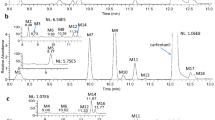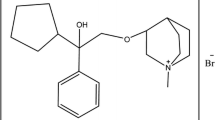Summary
Lidocaine has been recently approved for use as an intranasal spray in the treatment of migraine. In this study, we investigated the metabolism of lidocaine to its primary metabolite monoethylglycine xylidide (MEGX), by rat nasal olfactory and respiratory microsomes. The metabolic parameters were compared with metabolism employing rat and human hepatic microsomes. The olfactory and respiratory microsomes both exhibited considerable activity for conversion of lidocaine to MEGX in comparison with the activity in the hepatic tissues. The rat olfactory microsomes had a markedly higher affinity than the rat hepatic or respiratory microsomes. However, the turnover rate was only about one-half that of rat liver. Employing Western immunoblotting we investigated the presence of cytochrome P450s (CYPs) 1A2, 3A2, 2B1 and 2C11 in rat nasal tissues; these isozymes are known to participate in the metabolism of lidocaine in rat liver. These isozymes were found to be present in significant amounts in both the nasal olfactory and respiratory tissue; this is the first known report of the presence of CYP2C11 in nasal mucosae. Our studies underscore the importance of CYP-mediated drug metabolism in nasal tissues. The effect of this ‘nasal first-pass’ should be weighed carefully while considering the fate and the bioavailability of drugs delivered via the intranasal route.
Similar content being viewed by others
References
Kudrow L., Kudrow D.B., Sandweiss J.H. (1995): Rapid and sustained relief of migraine attacks with intranasal lidocaine: preliminary findings. Headache, 35: 79–82.
Hermansson J., Glaumann H., Karlen B., Von Bahr C. (1980): Metabolism of lidocaine in human liver in vitro. Acta Pharmacol. Toxicol., 47, 49–52.
Imaoka S., Enomoto K., Oda Y. et al. (1990): Lidocaine metabolism by human cytochrome P-450s purified from hepatic microsomes: comparison of those with rat hepatic cytochrome P-450s. J. Pharmacol. Exp. Ther., 255, 1385–1391.
Parker RJ., Collins J.M., Strong J.M. (1996): Identification of 2,6-xylidide as a major lidocaine metabolite in human liver slices. Drug Metab. Dispos., 24, 1167–1173.
Imaoka S., Yamada T., Hiroi T. et. al. (1996): Multiple forms of human P450 expressed inSaccharomyces cerevisiae: systemic characterization and comparison with those of the rat. Biochem. Pharmacol., 51: 1041–1050.
Sallie R.W., Tredger J.M., Williams R. (1992): Extrahepatic production of the lignocaine metabolite monoethylglycinexylidide (MEGX). Biopharm. Drug Dispos., 13: 555–558.
Tanaka K., Oda Y., Asada A., Fujimori M., Funae Y. (1994): Metabolism of lidocaine by rat pulmonary cytochrome P450. Biochem. Pharmacol., 47, 1061–1066.
Sarkar M.A. (1992): Drug metabolism in the nasal mucosa. Pharm. Res., 9, 1–9.
Blumer J., Strong J.M., Atkinson AJ. (1973): The convulsant potency of lidocaine and its N-dealkylated metabolites. J. Pharmacol. Exp. Ther., 186: 31–36.
Haseman J.K., Crawford D.D., Huff J.E., Boorgman G.A., McConnell E.E. (1984): Results from 86 2-year carcinogenicity studies conducted by the National Toxicology Program. J. Toxicol. Environ. Health, 14: 621–640.
Haseman, J.K., Hailey, J.R. (1997): An update of the National Toxicology Program database on nasal carcinogens. Mutat. Res., 380: 3–11.
Maizels M., Scott B., Cohen W, Chen W. (1996): Intranasal lidocaine for treatment of migraine: a randomized, doubleblind, controlled trial. JAMA, 276, 319–321.
Genter M.B., Deamer N.J., Cao Y., Levi P.E. (1994): Effects of P450 inhibition and induction on the olfactory toxicity of β, β′ iminodipropionitrile (IDPN) in the rat. J. Biochem. Toxicol., 9: 31–39.
Kawai R., Fujita S., Suzuki T. (1985): Simultaneous quantitation of lidocaine and its four metabolites by high-performance liquid chromatography: application to studies onin vitro andin vivo metabolism of lidocaine in rats. J. Pharm. Sci., 74: 1219–1224.
Akaike A. (1978): Posterior probabilities for choosing a regression model. Ann. Inst. Math. Stat., 30: A9-A14.
Schwarz G. (1978): Estimating the dimension of a model. Ann. Stat., 6: 461–464.
Moore K.H., Hussey, E.K., Shaw S., Fuseau E., Duquesnoy C., Pakes G.E. (1997): Safety, tolerability, and pharmacokinetics of sumatriptan in healthy subjects following ascending single doses and multiple intranasal doses. Cephalgia, 17: 541–550.
Gallagher R.M. (1996): Acute treatment of migraine with dihydroergotamine nasal spray. Arch. Neurol., 53: 1285–1291.
Melanson S.W., Morse J.W., Pronchik D.J., Heller, M.B. (1997): Transnasal butorphanol in the emergency department management of migraine headache. Am. J. Emerg. Med., 15: 57–61.
Levy R.L. (1995): Intranasal capsaicin for acute abortive treatment of migraine without aura. Headache, 35: 277.
Sakane T., Akizuki M., Taki Y, Yamashita S., Sezaki H., Nadai T. (1995). Direct drug transport from the rat nasal cavity to the cerebrospinal fluid: the relation to the molecular weight of drugs. J. Pharm. Pharmacol., 47: 379–381.
Dahl A.R., Hadley W.M. (1991): Nasal cavity enzymes involved in xenobiotic metabolism: effects on the toxicity of inhalants. Crit. Rev. Toxicol., 21: 345–372.
Genter M.B., Liang H.C., Gu J. et al. (1998): Role of CYP2A5 and 2G1 in acetaminophen metabolism and toxicity in the olfactory mucosa of theCypla2(-/-) mouse. Biochem. Pharmacol., 55: 1819–1826.
Bogdanffy M.S., Mathison B.H., Kuykendall J.R., Harman A.E. (1997): Critical factors in assessing risk from exposure to nasal carcinogens. Mutat. Res., 380, 125–141.
Harkema J.R. (1990): Comparative pathology of the nasal mucosa in laboratory animals exposed to inhaled irritants. Enivron. Health Perspect., 85: 235–238.
Jafek B.W., Johnson E.W., Eller P.M., Murrow B. (1997): Olfactory mucosal biopsy and related histology. In: Seiden A.M. (ed.) Taste and Smell Disorders, New York: Theime Medical, 107–127.
Gervasi P.G., Longo V., Naldi F., Panattoni G., Ursino F. (1991): Xenobiotic metabolizing enymes in human respiratory nasal mucosa. Biochem. Pharmacol., 41, 177–184.
Author information
Authors and Affiliations
Rights and permissions
About this article
Cite this article
Deshpande, V.S., Genter, M.B., Jung, C. et al. Characterization of lidocaine metabolism by rat nasal microsomes: implications for nasal drug delivery. Eur. J. Drug Metab. Pharmacokinet. 24, 177–182 (1999). https://doi.org/10.1007/BF03190366
Received:
Issue Date:
DOI: https://doi.org/10.1007/BF03190366




